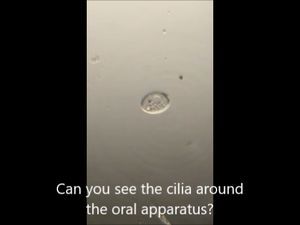Halteria, the virovore
 Mar 08, 2023 • 10:06 PM UTC
Mar 08, 2023 • 10:06 PM UTC United States
United States 140x Magnification
140x Magnification Microorganisms
Microorganisms
Laks Iyer
Human observer of life. https://sukshmadarshin.wordpress.com
97posts
1255comments
5locations

Exploring pondwater is an endless fascination. One can also do the following: take some mud from a pond and store it for whenever you want to use it. Add some water when you are ready and then see the progression of life over the next few days. Its been about 10 days since I did so for this sample and the sample is filled with a great number of ciliates. Here is an old favorite, "Halteria'. I have used slow motion to slow down its Saltation/Halting motion.
I had written a bit about it in an older post.
https://microcosmos.foldscope.com/?p=transfer_10177
It is about 30 microns in diameter and the way to identify the ciliate is the by its ciliary arrangement and the sudden abrupt change in the direction of motion where it springs up to 7 body-lengths. I still think it jumps in the direction opposite to its oral apparatus. Apparently, the middle part of the protist has cilia that help it jump these enormous distances, somewhat like a pole vault. The thing is that if this motion helps it to avoid predators then why does it do it when there is none? Apparently the jumping motion can be induced by water currents and it takes up to 40% of this metabolic rate. Quite a costly affair.
Here is a fun fact, did you know that Halteria can eat giant viruses? They are hence appropriately called virovores. Here is the paper discussing this.
https://www.pnas.org/doi/10.1073/pnas.2215000120
https://microcosmos.foldscope.com/?p=transfer_10177
It is about 30 microns in diameter and the way to identify the ciliate is the by its ciliary arrangement and the sudden abrupt change in the direction of motion where it springs up to 7 body-lengths. I still think it jumps in the direction opposite to its oral apparatus. Apparently, the middle part of the protist has cilia that help it jump these enormous distances, somewhat like a pole vault. The thing is that if this motion helps it to avoid predators then why does it do it when there is none? Apparently the jumping motion can be induced by water currents and it takes up to 40% of this metabolic rate. Quite a costly affair.
Here is a fun fact, did you know that Halteria can eat giant viruses? They are hence appropriately called virovores. Here is the paper discussing this.
https://www.pnas.org/doi/10.1073/pnas.2215000120
Sign in to commentNobody has commented yet... Share your thoughts with the author and start the discussion!

 0 Applause
0 Applause 0 Comments
0 Comments_300x300.jpeg)

















